Laura Hiscott reviews The Spacefarer’s Handbook by Bergita and Urs Ganse

For much of the last year and a half, planning international travel, sometimes even national travel, has been for most of us wishful thinking. But Bergita and Urs Ganse, the authors of The Spacefarer’s Handbook, have something even more ambitious on their minds. They are scientist siblings, Urs a theoretical space physicist, and Bergita a space physician, and their book is a thorough guide to space travel for biological beings.
From building resilient spacecraft, to the physics of orbital navigation and atmospheric re-entry, it leaves no stone unturned. The chapters about life in space demonstrate just how much more complex it is to send a person into space than to send a machine, detailing how everything from sleep cycles to our sense of taste are affected by a microgravity environment.
The chapter on space medicine might be off-putting for some would-be space farers, with sections on “puffy face-bird legs syndrome”, “shrinking hearts” and “G-measles”. However, the exploration of the psychological impacts of space travel may be surprisingly relevant for readers right now – astronauts are not the only ones who have found themselves enclosed in a small space with very few other people during the last year.
The handbook was originally written in German but has been translated and published in English this year. The occasional phrasing betrays this, but it does not detract from the book as a fun and informative read. There are many pictures and diagrams, which help to explain both the challenges of these far-reaching voyages, and the ingenuity that might help us to achieve them.
- 2020 Springer £19.99pb 307pp



